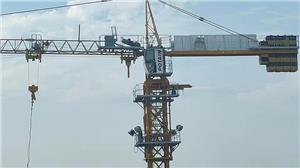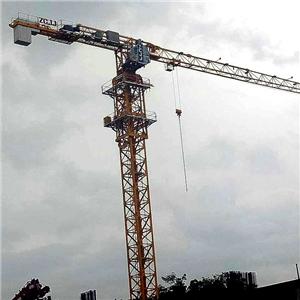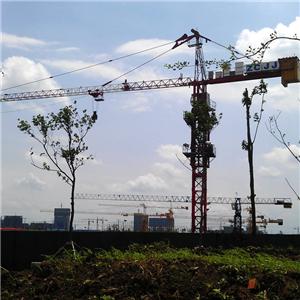Analysis of Causes, Hazards and Precautionary Measures of Loose of Stair Sling Standard Connection Bolt tower crane
Tower Hang Standard Festival Introduction:
The tower crane standard section is attached to the tower crane's own overhead device, and a section of assembly forms the "trunk" of the tower crane, which acts as a support for the upper working parts, mainly bearing the axial pressure from the top working parts. Horizontal force, bending moment and torque. The standard bolt loosening of the tower crane is a tower body that adopts the form of bolt sleeve connection between the standard joints. At present, most small and medium-sized tower cranes(60t · M and below) of the tower crane manufacturers use this form of connection, and the bolts are all high strength bolts. However, in the daily inspection of the tower crane, there are many cases where the connection bolt is loose. What is the reason why the standard bolt of the tower crane is loose? Below, the following discussion is made on the analysis of the causes, hazards and preventive measures of the loose bolt of the standard joint of tower crane.
The reasons for the loose bolt of the standard joint connection of the tower crane:
We first analyze the force characteristics of the tower body. The force of the tower body can be simplified to: moment M perpendicular to the horizontal plane, torque T in the horizontal plane, axial pressure N, horizontal force F, in which M, T has a greater impact on bolt loosening.. When the boom is lifted, M is positive, and M is negative after the weight is put down. The T generated at the turn start is positive, and the T generated at the turn brake is negative. During normal work, the tower crane frequently lifts and puts down heavy objects, and the crane arm is repeatedly started and braking, so that the tower body suffers from frequent changes in the moment and torque of positive and negative alternation, resulting in repeated changes in the force of the standard joint connection bolt. This is the fundamental reason why the bolt is loose. The working characteristics of the tower crane determine the force characteristics of the standard joint joint bolt, which is insurmountable. For this reason, each tower crane manufacturer adopts high strength bolts to the tower crane standard joint bolt. The specification of the tower crane and the instructions for the use of the tower crane manufacturers both require the installation of this bolt connection, require pre-tightening force at the time of installation, and give different pre-tightening values for the connection bolts of different specifications. For the commonly used 8.8 M24 bolts, the pre-tightening force is: 155KN. To achieve accurate pre-tightening force, the tightening torque on the bolt must be applied according to the torque coefficient of the high-strength bolt.
For the 8.8 M24 bolt mentioned above, the theoretical pre-tightening torque is approximately 700N · M. In the current Chengdu area, the installation of Tower hoists is almost entirely based on the experience of operating workers to tighten bolts. Many operators do not even have the concept of prescribed pre-tightening force and theoretical pre-tightening torque, let alone use torque to control bolt pre-tightening. force. Also, tightening the standard section connection bolt is operating at high altitude. The operating conditions are not good. If you want to apply the actual pre-tightening torque to 500N, the labor intensity of the worker will greatly increase. If you want to directly rely on manpower, the pre-tightening torque will be screwed to meet the requirements. Not easy to do.
It can be seen that the bolt pre-tightening force of the tower crane actually installed almost does not meet the stipulated pre-tightening force requirements. This is an important reason for bolt loosening. Also, when the tower ceiling is lifted and knotted, the standard joint connection contact surface on the side of the crane arm is pulled, and the standard joint connection contact surface on the balance arm side is pressed. Under the same tightening torque, the pre-tightening force in the bolts on both sides is equal. When the tower crane rotates and the direction of the crane arm changes, the pressure and pull of the standard contact surface of the tower body changes greatly, and the force in the bolt changes greatly, especially to turn the crane arm in the opposite direction to the top joint. The contact surface of the standard joint connection on the side of the original boom is changed from drawn to pressed, and the tension of the bolt is greatly reduced. Especially when the original pre-tightening force is much less than the correct value, there will be no pre-tightening force. This is another important reason why the bolt is loose. In other units, the management of the tower crane is extremely not strict. The bolts originally equipped with a double nut(a thick stress nut, a thin anti-loose nut) were installed with only one nut. The bolts are connected to the original anti-loosening measures. It also works under frequent alternating loads and is easy to loosen. In addition, the management of the tower crane team was not in place. The operators neglected to check and tighten the bolts. Once the bolts were loose, they did not find the fastening in time, which worsened the force conditions of other bolts and caused more bolts to be loose.
Hazards of loosening of the standard link bolt for tower hoist:
The standard joint connecting bolt of the tower body is not allowed to loose, and its damage is extremely serious. Article 2.2.2.2 of the Building Tower Crane Safety Regulations(GB5144-2006) expressly states: "The connection bolts must be screwed with a torque wrench or a special wrench and tightened according to the assembly technical requirements." The same is also required in the instructions for the use of such tower cranes.. After the bolt is loose, when the bending moment produces tension in the standard joint main limb of the bolt orientation, the gap between the two standard joints will be created. For a tower crane with a height of 30m that is not attached, a gap of 0.1 mm is generated at the second and third standard joints in the lower part. The horizontal displacement at the base of the crane will increase by 2mm. If multiple contact surfaces generate gaps, the deformation of the tower body will increase dramatically., The force on the tower body is even more unfavorable, and it even leads to a tower accident. After the bolt is loose, under the action of the upper load of the tower crane, the contact surface of the two standard joints that should have been fixed together will inevitably produce axial yearning complex movement, and the impact load will be generated between the bolt connection structures that originally had no impact load. The load effect in bolt and connection structure is greatly increased, which can easily lead to damage of bolt and connection structure, and even break of Tower body. From this we can see how dangerous it is not to find or ignore the loosening of the standard joint bolt in time!
Precautions for the loosening of the standard link bolt of the tower crane:
1. The tower crane management unit shall strengthen the management and supervise the tower crane working group(or special maintenance team) to regularly inspect and tighten the standard bolt. According to experience, the standard bolt should be checked at least once a week. If looseness is found, tighten it in a timely manner.
2. Adopt reasonable method to tighten standard bolt. The rotary boom is commonly used to tighten the bolts on the side of the tower. The inspection in daily use is tightened. In the empty loading state of the tower, the car is moved to the base of the arm, and the bolts on the side of the arm are checked from the bottom and secured. After this side is finished, the boom is rotated 180 degrees. Check and tighten the bolts on the other side from top to bottom until complete. Check and tighten the newly installed standard section bolts according to the above method after each top lift.
3. When tower crane is installed, strengthen the work of safety technology. Be sure to explain to the installer the hazards of insufficient pre-tightening force of the standard joint bolt, and the theoretical pre-tightening torque of the standard joint bolt of the tower crane installed(to specify how long the rod is used and how much force is applied). And the correct fastening order of the standard section bolts.
4. Strict tower hanging management, tower hanging plant accessories must not unreasonable omission and replacement, especially functional parts.
5. The construction unit's machinery management department carries out inspections on the tower crane, and must be carefully checked by someone on the plane. The inspection of the problem is timely notified to the tower crane's competent unit and the hidden dangers are promptly rectified.
The fastening of the tower crane standard joint bolt is a matter that is easy to say and difficult to do in practice, but it also has a great relationship with the safe use of the tower crane. We hope that the large number of tower crane manufacturers and supporting manufacturers, building machine research units, enhance the understanding of this aspect, develop good methods and tools, and strengthen the management of each construction unit to ensure the safe use of tower crane.




